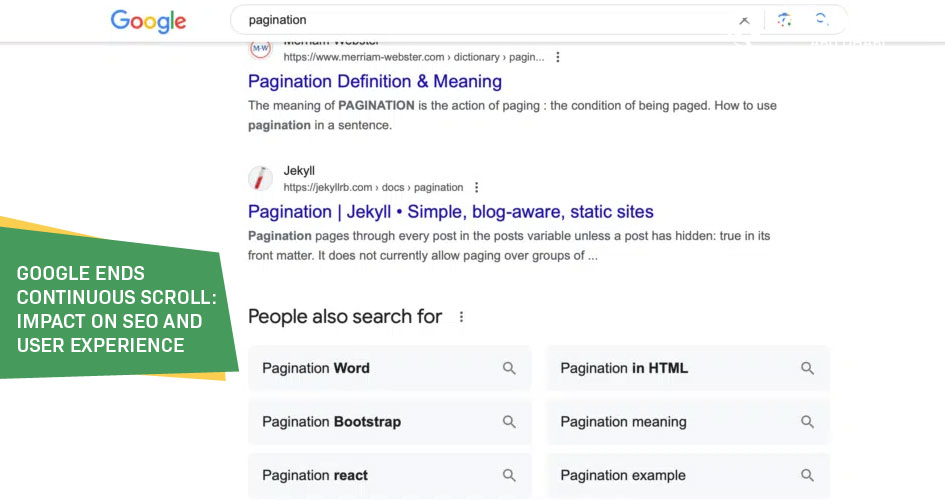
It was only a few days ago that the company declared that they are deprecating the infinite scrolling option on the SERPs. The feature that permitted users to scroll down to access more search results without having to click on a ‘load more’ button has been available since October 2021.
Not only in terms of aesthetics but in functionality too, the modifications made to the SERPs are quite profound, and they will affect users and web resources that depend on the traffic from Google. To ensure you understand what the details of this update entail and what it really means, here is a comprehensive post from the leading SEO experts.
Continuous Scroll was First Adopted by Google to Answer the Following Query:
When the scroll was initiated, Google said that through their experience, some users appreciated the fact that they could continue scrolling through the SERPs without being interrupted by the “See More” buttons. Some of the benefits of continuous scrolling highlighted by Google included:
- Quicker access to various results and a greater possibility of considering a larger number of outcomes.
- Clicking for more pages was considerably less frequent.
- Greater usability for the consumers who use the mobile version of the website.
It used to be for improving the search experience; however, it appears that the company has now decided that the downsides outweigh such advantages.
Why is Google Changing a Feature?
When rolling out the implementation that stopped the continuous scroll, Google noted that this change was in response to advertiser’s and users’ dissatisfaction with the feature. Specifically, two major drawbacks led to this update:
- Lack of Ease in Assessing Result Relevance – with more results coming in, as is the case with real-time search, users noted that they found it hard to assess the relevance of the results and when they could stop searching for more results.
- Confusion in Site Separation – Websites that extended in long horizontal trails also posed difficulty for users to identify sites and distinguish when they were shifted to a distinct site.
Both of these factors probably lowered click rates and made it tougher for sites to rank themselves in SERPs, which would have disadvantaged the user experience and value of website visitors.
What Consequences Can Be Made Out of This Alteration?
Returning to paginated SERPs will:
- Enhance User Categorisation – With separate pages for indexed results, users will have a better chance of going through the entire title, description and URL to pass the verdict of relevance.
- Higher Click-Through-Rates – The increase in CTR can be attributed to the clear distinction made for result listings where users can discern sites easily.
- Help SEO – Further search result divisions after the first couple of results will bring the ranking back to the top of page one. It is possible for sites that have recovered their ranking to experience increases in traffic.
In general, these changes show that paginated indexes are more in tune with what the user wants and that the general process of searching is improved.
So, What Should Website Owners Do?
Thus, Local SEO Companies or website owners require no special technical actions to address this update. Take a look:
- Monitor Rankings: Use this to check the general rankings of your pages and whether they recapture their previous positions or whether the CTR has increased.
- Check on the Site Layout: Review the site design to confirm that it enables easy distinction and quick horizontal scanning of the page. It is also significant not to mix up page titles, headings, and content organisation.
- Quality Content: Developing relevant, valuable content for users and their purpose attracts clicks and a CTR, whether SERP is featuring more links.
- Further Development: Search is inherently changing to adapt to users’ demands, so one must follow the latest Google updates.
However, the change to this scroll has been rolled back, and further improvements to the algorithms will make the search better in the future. In terms of SEO and content, the main idea to consider is to identify and satisfy user expectations.
Conclusion
The removal of the continuous scroll SERPs will likely be a positive change for websites attempting to gain traffic from Google as well as users looking for relevant information. This way, it will be easier to analyse the results because there will be a clear distinction between subsites within the main site.
The webmasters should be watching their ranks shift but not make any significant changes to their sites because of this change. An emphasis on the quality of the website design and content as an approach to the promotion of clickable links and positions in Google searches is relevant in the long term, regardless of the use of pagination.




